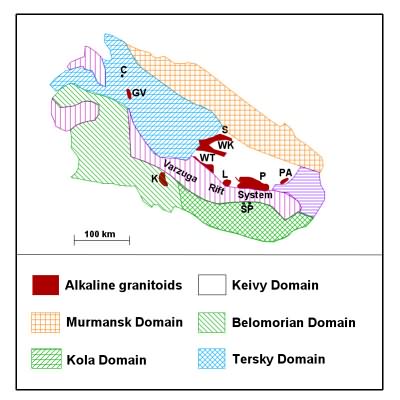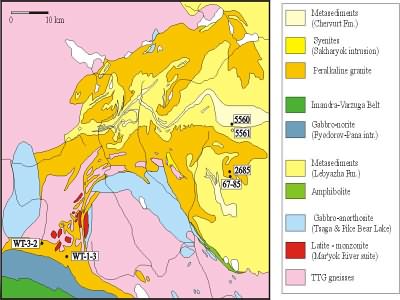 U. Mass Lowell
U. Mass Lowell |
Prof. Nelson Eby | Department of Environmental, Earth, & Atmospheric Sciences |
|
The Keivy alkaline province consists of six peralkaline granite bodies (massifs) with a total exposed area of 2500 km2, alkaline syenogranite dikes and two nepheline syenite fault-type intrusions (top figure at right). The granite massifs were emplaced between the tonalite-trondjemite-granodiorite (TTG) basement and the supracrustal Keivy terrane, which is mainly composed of dacite-rhyolite metavolcanic rocks and metasedimentary rocks (bottom figure at right). Most of the massifs are sheet-like bodies with thicknesses of a few hundred meters. Syenogranites represent the first magmatic phase in the peralkaline granite massifs. Peralkaline granites constitute the second and most abundant magmatic phase. Most massifs are bounded by voluminous gabbro-anorthosite intrusions. U-Pb zircon ages for the various massifs range between 2613 Ma and 2682 Ma. Based on these ages, the Keivy alkaline province is one of the earliest examples of felsic alkaline magmatism. The present project is a collaborative study, with Dmitry Zozulya, Tamara Bayanova, and Felix Mitrofanov of the Kola Science Centre. The purpose of the study is to characterize the petrography, geochronology, and geochemistry of the A-type granitoids and related rocks. Major elements, some trace elements, and Nd and Sr isotopes are determined at the Kola Science Centre. Other trace elements are determined by INAA at Lowell. U-Pb zircon ages are determined at the Kola Science Centre. Publications resulting from the present study and pictures of the Kola area are found below. |
 |
 |
|
|
Zozulya, D. and Eby, N. The
Keivy alkali granite complex consists of 2650-2660 Ma aegirine-arfvedsonite
granites (six sheet-like massifs of a few hundred meters thickness and a total
exposure area of ca. 2500 km2), 2670 Ma
aegirine-augite-lepidomelane-ferrohastingsite syenogranites that occur in the
margins of some massifs, and 2680 Ma lepidomelane-ferrohastingsite syenite dykes
that intrude the TTG basement of the Central Kola terrane (NE Fennoscandian
shield). Small dike-like bodies of 2610 Ma nepheline syenite cut the West Keivy
alkali granite massif. On standard trace element discriminant diagrams (Whalen
et al., 1987; Pearce et al., 1984; Eby, 1990) the Keivy alkali granites plot as
within-plate or post-collisional A-type granitoids. The least evolved
syenogranites plot in the EM2-field on the εSr - εNd diagram. The low
Y/Nb and Yb/Ta ratios for the associated nepheline syenite indicate an OIB
affinity. The rocks of the Keivy complex are extremely enriched in Zr (300-5000
ppm), Y (40-500 ppm), Nb (20-600 ppm), Rb (160-900 ppm), REE (100-1000 times
chondrites). The numerous associated Zr-Y-REE-Nb ore occurrences and deposits
are associated with different lithologies and formed by different genetic
processes (Fig.; Table). The Keivy alkali granite complex is the only known
Archean fertile A-type granite in the world.
References: Eby, G.N., 1990. The A-type granitoids: a review of
their occurrence and chemical characteristics and speculations on their
petrogenesis. Lithos 26, 115-134. Pearce, J., Harris, N., Tindle, A., 1984. Trace element
discrimination diagrams for the tectonic interpretation of granitic rocks.
Journal of Petrology 25, 956-983. Voloshin, A.V., Pakhomovsky, Ya.A., 1986. Minerals and
evolution of mineral genesis in amazonite pegmatites of the Kola Peninsula.
Leningrad, Nauka. (in Russian) Whalen, J., Currie, K., Chappell, B., 1987. A-type
granites: geochemical characteristics, discrimination and petrogenesis.
Contributions to Mineralogy and Petrology 95, 407-419.
Zozulya, D., Bayanova, T., Eby, N., Kullerud, K., and Ravna, E. Archean alkaline complexes are extremely rare but are of particular interest because the magmas have a mantle origin. Given their high Sr and Nd contents, crustal contamination has only a minor impact on the mantle-derived isotopic signatures. Therefore, they can provide valuable information on the isotopic composition of the subcontinental mantle and geodynamics in Archean. The previously reported Late Archean alkaline complexes (2.7-2.6 Ga) from the Canadian and Australian shields belong to the potassic series, are depleted in LIL and HFS elements, and are related to subduction, thereby forming in a compressive tectonic environment and having a depleted mantle source. The absence of Archean sodic alkaline complexes forming in extensional environments was mainly ascribed to the absence of metasomatic processes in the mantle and lower lithosphere (Blichert-Toft et al., 1996). Greenland Archean alkaline complexes (2698-2664 Ma syn- to post-kinematic pyroxenites, hornblendites, norites and diorites, monzodiorites, monzonites, syenites, nephelenitic rocks and carbonatites) are found in the Skjoldungen province in the SE Nain craton (Blichert-Toft et al., 1995). The Baltic examples are the 2610 Ma Siilinjarvi carbonatite-glimmerite intrusion, SW Karelian craton, and the Keivy alkaline province (2670-2654 Ma anorogenic peralkaline granites, syenogranites, syenites and massif-type anorthosites; 2610 Ma OIB-like nepheline syenites and essexites), Kola craton. The 2695 Ma Mikkelvik nepheline syenite stock was recently identified in the West Tromso Archean basement, Northern Norway. The alkaline rocks mostly show high contents of some incompatible elements (REE, Zr, Y, Nb, and Rb, high Ga/Al (for granite) and low Y/Nb and Yb/Ta (for syenite) ratios) characteristic of an enriched mantle source. Near chondritic and negative eNd (0 to -5) and near chondritic and positive eSr (0 to +50) suggest the mantle source is transitional between the chondritic and enriched mantle (EM2) reservoirs. From the similar geochemical signatures it is suggested that the Archean alkaline magmatism from Greenland, the Baltic and Northern Norway resulted from plume development in a sub-lithospheric mantle having enriched characteristics due to subduction. The observed differences in geochemical features are in accordance with a sequence of magmatic events during the plume development: 2.70-2.66 Ga - initiation, near chondritic and slightly enriched reservoir due to subducted and recycled oceanic crust, mafic shoshonitic parental magma; 2.65-2.61 Ga - evolved enriched reservoir, OIB-like and Na-rich parental magma.
Zozulya, D.R. and Eby, G.N. A
suite of massif-type anorthosites and peralkaline granites is found in the
Archean Keivy terrane of the NE Baltic shield. The 2660-2680 Ma Keivy
anorthosite complex consists of several large (up to the 170 km2)
lopoliths composed mainly of anorthosite and gabbro-anorthosite and marginal
gabbro-norite and titanomagnetite-rich troctolite bodies. The Keivy anorthosites
have low REE abundances (Ce 5-23 and Yb 1.5-6.8 times chondrites), fractionated
REE distributions (chondrite-normalized La/Yb ratios are 4-10) and positive Eu
anomalies. The comagmatic gabbro-norites have similar REE patterns, but no or
negligible positive Eu anomalies. The rocks show high compatible element (Sc,
25-40 ppm and Sr, 460-670 ppm) abundances. As the chondrite-normalized La/Yb
ratios do not correlate with REE abundances, an enriched source for the primary
magmas is proposed. The enriched source for the Keivy anorthosites has low eNd
(-0.15 to -0.24) and low Y/Nb ratios (0.6-1.3). From the geochemical data it is
inferred that the primary magma was an alkaline/subalkaline basalt magma forming
in a within-plate setting. The
Keivy peralkaline granite complex consists of 2650-2660 Ma peralkaline granites,
2670 Ma syenogranites, and 2680 Ma alkaline syenites. The granites form
sheet-like bodies with thicknesses of a few hundred meters, but have vast
exposed areas (100-1200 km2). They are metamorphosed to amphibolite
facies and are bounded by gabbro-anorthosite. The rocks of the Keivy complex are
extremely enriched in Zr (300-1900 ppm), Y (40-150 ppm), Nb (20-150 ppm), REE
(100-1000 times chondrites) and Rb (160-900 ppm), have associated Zr-REE ore
occurrences, are very low in Sc (0.3-1.3 ppm) and Sr (10-30 ppm), show negative
Eu anomalies, have normalized La/Yb ratios of 1.5-13 and
high Ga/Al ratios. On standard trace element discriminant diagrams the Keivy
peralkaline granites plot as within-plate or post-collisional A-type granitoids.
The low Y/Nb and Yb/Ta ratios for associated alkaline syenites point to their
OIB affinities. The least metamorphosed and least evolved rocks plot in the
EM2-field on the eSr
- eNd
diagram. The close temporal and spatial association of the gabbro-anorthosites and the peralkaline granites and their similar magma sources suggest a genetic relationship. One possible model is protracted fractional crystallization of a primary alkaline basalt magma with removal of plagioclase during the early stages of crystallization (forming a Ca- and Al-enriched cumulate, anorthosite) and alkali, iron and HFSE enrichment of the residual melt leading to the peralkaline granites.
Geology and age of the Late Archaean Keivy alkaline province, NE Baltic Shield Zozulya, D. R., Bayanova, T. B., and Eby, G. N. The Keivy alkaline province, Kola Peninsula, consists of six peralkaline granite bodies, alkaline syenogranite dikes, and two nepheline syenite intrusions emplaced between the tonalite-trondhjemite-granodiorite basement and the supracrustal Keivy terrane. U-Pb zircon ages for the Keivy alkaline province range from 2613 to 2682 Ma and, for the spatially associated gabbro-anorthosite complexes, from 2659 to 2668 Ma. The Keivy alkaline granitoids are geochemically different from other Late Archean alkaline rocks inferred to have been emplaced in subduction zone settings. The Keivy alkaline province may represent the earliest example of magmatism associate with continental rifting and the involvement of a mantle plume with oceanic island basalt-like characteristics.
Late Archean Felsic Alkaline Magmatism: Geology, Geochemistry, and Tectonic Setting Zozulya, D. and Eby, N. The oldest known examples of felsic alkaline magmatism are from the Superior province, Yilgarn Craton, and Fennoscandian Shield. These are the 2680-2670 Ma alkaline granites and associated nepheline syenite stocks of the Abitibi greenstone belt (Sutcliffe et al., 1990; Corfu et al., 1991): the 2650-2630 Ma alkaline granites and syenites of the Mount Monger, Emu, Claypan, and Ninnis suites of the Eastern Goldfields granite-greenstone terrane (Libby, 1989; Smithies, Champion, 1999): and the 2610-2680 Ma alkaline granites, syenogranites, and nepheline syenites of the Keivy complex of the Central Kola granite-greenstone domain (Mitrofanov et al., 2000; Zozulya et al., 2001). The Superior and Yilgarn felsic alkaline rocks form small (10-90 km2) stocks that are spatially and temporally associated with potassic volcanics and lamprophyres. The Kola examples form sheet-like bodies with thicknesses of a few hundred meters, but have vast exposed areas (100-1300 km2). They are metamorphosed to amphibolite facies and are closely associated with large gabbro-anorthosite bodies. While the various provinces have the common mineralogical (anhydrous primary phases, Fe- and Na-rich mafic silicates) and petrochemical (low Ca, Mg, Al, and high total alkalis) characteristics of alkaline granites they show different trace element characteristics and mineralization types. The Superior and Yilgarn alkaline granites and syenites have extremely low Ga/Al and high (La/Yb)n ratios, no Eu anomaly, and related Au mineralization. Based on these geochemical features the granites were formed in a subduction environment and correspond to volcanic arc granites. In contrast, the rocks of the Keivy complex are extremely enriched in Zr, Y, Nb, REE, and Rb, have associated Zr-REE ore occurrences, are very low in Ba and Sr, show distinct negative Eu anomalies, and have low (La/Yb)n and high Ga/Al similar to A-type granitoids forming in within plate settings. The low Y/Nb and Yb/Ta ratios for the associated nepheline syenites point to their OIB affinities. The felsic alkaline magmatism of the Superior and Yilgarn provinces is related to the final stages of greenstone-belt formation (the ages are 2725-2680 Ma and 2720-2675 Ma, respectively). The Keivy complex was formed long after the development of the adjacent greenstone belt (the formation age is 2920-2830 Ma) and reflects the influence of a mantle plume.
|